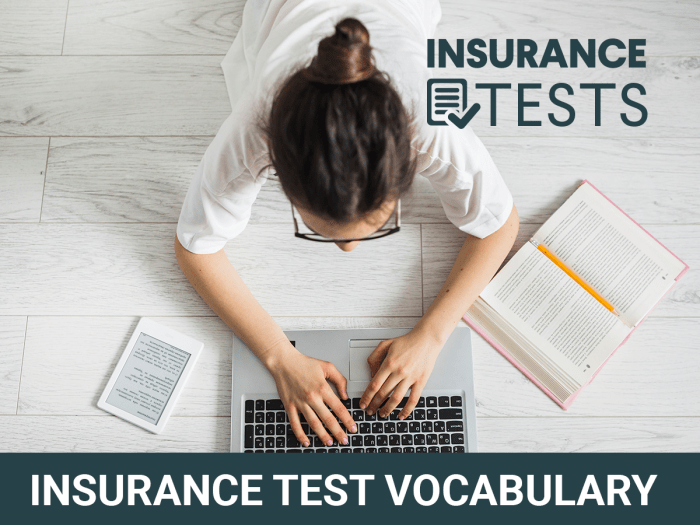In the realm of financial security, life and health insurance serve as essential pillars, safeguarding individuals and families against unforeseen events. To become a proficient insurance professional, one must successfully navigate the comprehensive Life and Health Insurance Exam, a gateway to unlocking a rewarding career.
This guide offers invaluable insights, practical strategies, and proven techniques to help aspiring insurance agents conquer this challenging assessment.
With dedication, effective study habits, and a deep understanding of insurance concepts, candidates can confidently embark on their journey towards exam success. Delving into the intricacies of life and health insurance policies, mastering essential terminology, and analyzing risk factors will equip individuals with the knowledge and skills necessary to excel in this dynamic field.
Understanding Insurance Concepts

Gaining a comprehensive understanding of insurance concepts is paramount in navigating the complex landscape of life and health insurance policies. These policies offer a safety net, providing financial protection against unforeseen events that may impact your life or health. Understanding the fundamental concepts, various types, and customization options available will empower you to make informed decisions, ensuring you select the most suitable coverage for your unique needs.
Types of Life Insurance
Life insurance policies provide a financial cushion for your loved ones in the event of your untimely demise. There are three primary types of life insurance policies:
- Term Life Insurance: This policy provides coverage for a specific period, such as 10, 20, or 30 years. It offers affordable premiums and is ideal for those seeking temporary coverage.
- Whole Life Insurance: This policy provides lifelong coverage, regardless of your age or health status. It also accumulates a cash value component that can be accessed during your lifetime for various purposes.
- Universal Life Insurance: This policy combines the features of term and whole life insurance, offering flexible premiums and death benefits. It also provides a cash value component that can be accessed for various needs.
Types of Health Insurance Plans
Health insurance plans offer coverage for medical expenses incurred due to illness or injury. There are three main types of health insurance plans:
- Health Maintenance Organizations (HMOs): HMOs provide comprehensive coverage through a network of healthcare providers. They typically offer lower premiums but may have limited provider choices.
- Preferred Provider Organizations (PPOs): PPOs offer more flexibility in choosing healthcare providers, both within and outside their network. They typically have higher premiums than HMOs but provide greater freedom of choice.
- Exclusive Provider Organizations (EPOs): EPOs are similar to HMOs, but they offer a more limited network of healthcare providers. They typically have lower premiums than PPOs but may have fewer provider options.
Riders and Endorsements
Riders and endorsements are additional coverage options that can be added to your insurance policy to customize it to your specific needs. Some common riders include:
- Accidental Death Benefit: This rider provides an additional death benefit if the insured dies as a result of an accident.
- Waiver of Premium Rider: This rider waives the premiums if the insured becomes disabled.
- Guaranteed Insurability Rider: This rider guarantees the insured’s ability to purchase additional coverage in the future without having to undergo a medical exam.
Mastering Insurance Terminology

Understanding insurance terminology is crucial for passing the exam and becoming proficient in the field. It enables you to communicate effectively, comprehend policies, and make informed decisions.
Comprehensive Glossary of Essential Terms
To begin, familiarize yourself with a comprehensive glossary of essential insurance terms and definitions. This glossary should cover all key concepts, including types of insurance, policy provisions, underwriting guidelines, and industry regulations.
Table of Commonly Confused Terms
Many insurance terms share similarities, which can lead to confusion. To clarify these distinctions, create a table comparing commonly confused insurance terms. This table should include the terms, their definitions, and examples illustrating their usage in real-world scenarios.
Strategies for Memorizing Key Terms
Memorizing key terms and their applications is essential for success on the exam. Here are some strategies to aid in memorization:
- Use flashcards: Create flashcards with terms on one side and definitions on the other. Regularly review these flashcards to reinforce your memory.
- Create mind maps: Construct mind maps that visually represent the relationships between different insurance terms. This technique helps organize and retain information more effectively.
- Practice using terms in context: Apply insurance terms in real-world scenarios to deepen your understanding and solidify their usage.
Analyzing Insurance Policies

Understanding insurance policies is essential for individuals seeking coverage and insurance professionals alike. A thorough analysis of an insurance policy helps determine the extent of coverage, exclusions, and the insured’s responsibilities.Insurance policies typically consist of several sections, each addressing specific aspects of the coverage.
The declarations page provides basic information about the insured, the policy, and the coverage limits. The insuring agreement Artikels the specific risks or events covered under the policy. Exclusions are events or situations that are not covered by the policy.Policy
limits, deductibles, and coinsurance play a crucial role in determining the coverage provided. Policy limits specify the maximum amount the insurer will pay for a covered loss. Deductibles are the initial amount the insured must pay out of pocket before the insurance coverage begins.
Coinsurance is a percentage of the loss that the insured is responsible for paying, typically after the deductible has been met.Common policy provisions include grace periods, cancellation terms, and renewal options. Grace periods allow the insured a certain amount of time to pay the premium after the due date without lapsing the policy.
Cancellation terms specify the conditions under which the policy can be canceled by either the insurer or the insured. Renewal options Artikel the process for renewing the policy at the end of the policy term.Understanding these policy provisions is crucial for the insured to make informed decisions about their coverage.
It also helps insurance professionals provide accurate advice and guidance to their clients.
Calculating Insurance Premiums

Insurance premiums are not set in stone; they are influenced by various factors and are determined through a meticulous process involving rating factors and underwriting guidelines. Understanding these elements is crucial for insurance companies and policyholders alike, as they impact the overall cost of insurance.
Factors Influencing Premiums
The calculation of life and health insurance premiums considers several factors that provide insights into the individual’s risk profile. These factors include:
- Age: As individuals age, their risk of health complications and mortality increases, leading to higher premiums.
- Health Status: Individuals with pre-existing health conditions or a family history of certain illnesses may face higher premiums due to their elevated risk of making claims.
- Lifestyle Habits: Engaging in risky behaviors, such as smoking, excessive alcohol consumption, or participating in hazardous sports, can increase the likelihood of health issues, resulting in higher premiums.
- Occupation: Certain occupations with inherent risks, such as those involving manual labor or frequent travel, may attract higher premiums.
Calculating Premiums: A Step-by-Step Guide
The process of calculating insurance premiums involves a series of steps that consider the aforementioned factors:
- Assess the Applicant’s Risk Profile: Insurance companies evaluate the applicant’s age, health status, lifestyle habits, and occupation to determine their risk level.
- Apply Rating Factors: Rating factors are numerical values assigned to each risk factor, with higher values indicating a greater risk. These factors are then multiplied by the base premium to determine the initial premium amount.
- Underwriting Guidelines: Underwriters use underwriting guidelines to further refine the premium calculation. These guidelines consider additional factors, such as the applicant’s financial stability and insurance history, to adjust the initial premium amount.
- Premium Discounts and Incentives: Insurance companies may offer discounts or incentives to policyholders who meet certain criteria, such as maintaining a healthy lifestyle or opting for a longer policy term. These discounts can reduce the overall cost of insurance.
Assessing Risk Factors

Insurance companies assess various risk factors to determine insurability, premium rates, and policy terms. Understanding these factors is crucial for individuals seeking life and health insurance.
Occupation and Hobbies
Certain occupations and hobbies are considered higher risk due to potential hazards or physical demands. Examples include firefighters, pilots, and skydivers. These activities may increase the likelihood of accidents, injuries, or health issues, which can impact insurability and premiums.
Medical History and Conditions
Medical history plays a significant role in assessing risk. Pre-existing conditions, such as heart disease, diabetes, or cancer, can affect insurability and premium rates. Insurance companies review medical records, including treatments, medications, and lifestyle factors, to evaluate the severity and potential impact of health risks.
Underwriting and Risk Mitigation
Insurance companies use underwriting to evaluate and mitigate risk factors. Underwriters assess the applicant’s overall health, lifestyle, and risk profile to determine insurability, policy terms, and premium rates. They may request additional medical information, such as lab results or doctor’s reports, to further assess the risk.
Preparing for the Exam

The final step in your journey to becoming a licensed life and health insurance agent is passing the exam. To ensure your success, a well-structured preparation strategy is crucial. This includes reviewing essential topics, managing exam anxiety, and practicing with mock exams.
First and foremost, review the entire syllabus, paying particular attention to the topics that carry the most weight. Create a study schedule that allocates sufficient time to each topic. Make use of available resources such as textbooks, online courses, and study guides.
Essential Topics to Review
- Insurance Fundamentals: Understand the basic concepts of life and health insurance, including types of policies, benefits, and riders.
- Insurance Regulations: Familiarize yourself with the regulations governing the life and health insurance industry, including state laws and federal regulations.
- Policy Analysis: Practice analyzing different types of insurance policies, identifying key provisions, and explaining policy terms and conditions.
- Risk Assessment: Learn how to assess risk factors associated with life and health insurance policies, including medical history, lifestyle habits, and occupational hazards.
- Premium Calculations: Understand how insurance premiums are calculated, considering factors such as age, health status, and policy coverage.
- Sales Techniques: Develop effective sales techniques to communicate the benefits of life and health insurance policies to potential clients.
In addition to reviewing the essential topics, it is equally important to manage exam anxiety and maintain focus during the test.
Managing Exam Anxiety
- Practice Relaxation Techniques: Engage in relaxation techniques such as deep breathing exercises or meditation to calm your nerves before and during the exam.
- Adequate Sleep: Ensure you get a good night’s sleep prior to the exam to be well-rested and focused.
- Positive Self-Talk: Replace negative thoughts with positive affirmations to boost your confidence and reduce anxiety.
- Arrive Early: Arrive at the exam venue early to avoid feeling rushed and stressed.
Finally, practicing with mock exams and reviewing previous exam questions is essential for success.
Practice with Mock Exams
- Take Mock Exams: Simulate the actual exam experience by taking practice tests under timed conditions.
- Review Previous Exam Questions: Analyze past exam questions to identify frequently tested topics and question formats.
- Identify Weak Areas: Use practice exams to identify areas where you need additional review and focus your studies accordingly.
- Time Management: Practice managing your time effectively during the exam to ensure you complete all sections within the allotted time.
Additional Resources

To supplement your exam preparation, leverage a range of resources to deepen your understanding of insurance concepts and enhance your exam readiness.
Seek out reputable online resources, such as industry blogs, webinars, and podcasts, to stay abreast of the latest developments and trends in the insurance sector.
Textbooks and Study Guides
Explore comprehensive textbooks and study guides tailored specifically for the life and health insurance exam. These resources provide in-depth coverage of the exam syllabus, offering detailed explanations, practice questions, and mock exams to simulate the actual exam experience.
Professional Organizations and Forums
Engage with professional organizations and online forums dedicated to insurance professionals. These platforms offer a wealth of information, including industry news, exam preparation tips, and opportunities to connect with peers and erfahrener professionals who can provide valuable insights and guidance.
Exam Prep Courses and Workshops
Consider enrolling in exam prep courses or workshops conducted by experienced instructors. These programs provide structured learning, personalized guidance, and access to practice exams, helping you refine your knowledge and build confidence in your exam readiness.
Final Summary

As you embark on this educational odyssey, remember that perseverance and unwavering commitment are your steadfast companions. Embrace the challenge, utilize the resources at your disposal, and trust in your ability to triumph. The Life and Health Insurance Exam may be a formidable test, but with diligent preparation and unwavering determination, you will emerge victorious, ready to embark on a fulfilling career in the insurance industry.
Questions and Answers
Q: How can I create an effective study plan for the Life and Health Insurance Exam?
A: Begin by familiarizing yourself with the exam syllabus, identifying key topics and allocating sufficient study time for each. Develop a structured schedule that incorporates regular study sessions, breaks, and practice exams. Create a dedicated study space free from distractions to maximize focus and retention.
Q: What are some strategies for memorizing essential insurance terminology?
A: Utilize flashcards, mnemonic devices, and practice quizzes to reinforce your understanding of key terms. Create visual aids such as mind maps or diagrams to link concepts and enhance retention. Regularly review terminology in the context of real-world scenarios to solidify your grasp of their practical applications.
Q: How can I effectively analyze insurance policies to identify key provisions and exclusions?
A: Read each policy section thoroughly, paying close attention to the declarations page, insuring agreement, and exclusions. Understand the significance of policy limits, deductibles, and coinsurance in determining coverage. Identify common policy provisions that impact the insured, such as grace periods, reinstatement options, and beneficiary designations.
Q: What are some tips for managing exam anxiety and maintaining focus during the test?
A: Prioritize self-care in the days leading up to the exam, ensuring adequate sleep, a balanced diet, and regular exercise. Arrive at the exam venue early to settle your nerves and familiarize yourself with the testing environment. During the exam, take deep breaths, read questions carefully, and allocate time wisely to avoid rushing.
Utilize breaks judiciously to refresh and refocus.



